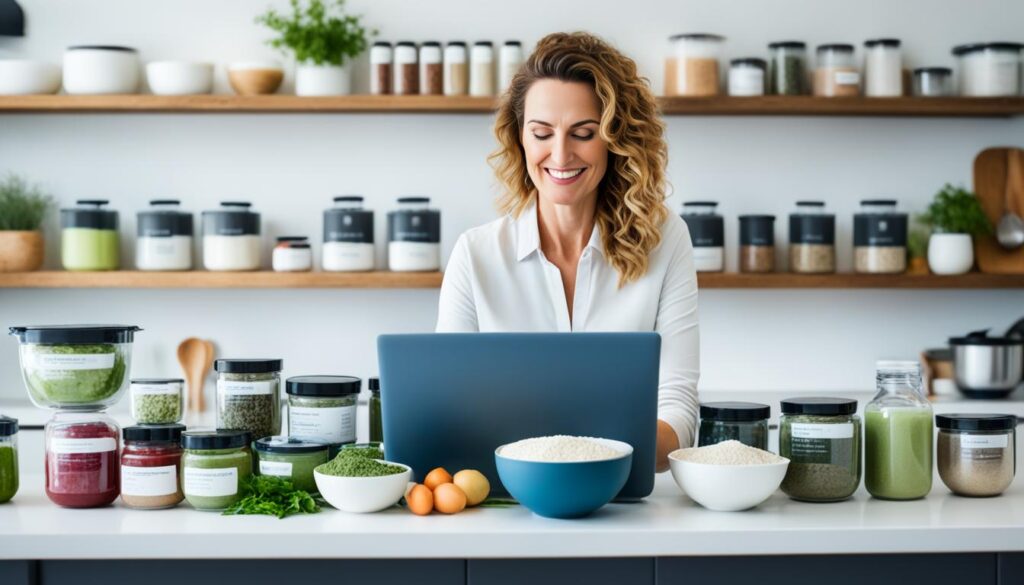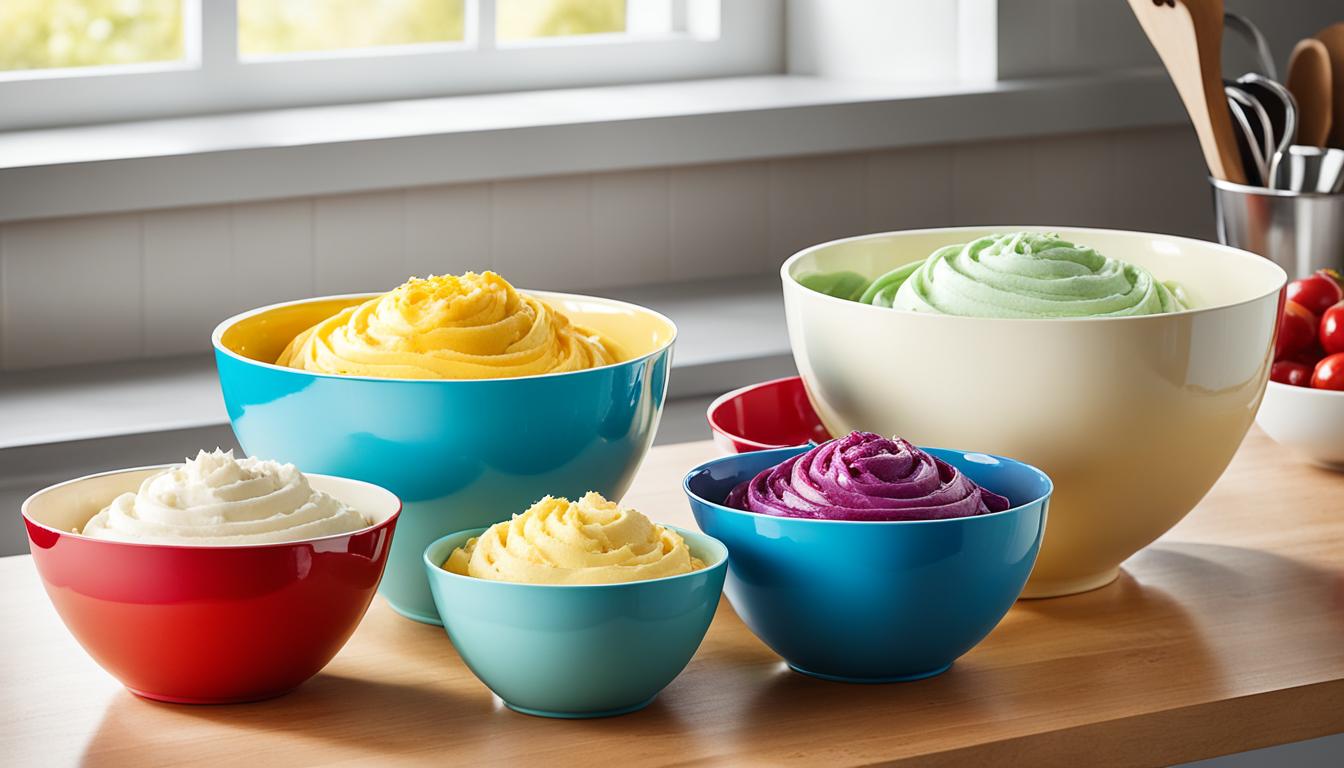When it comes to kitchen essentials, having a set of high-quality mixing bowls is a must. They serve many purposes, from stirring ingredients to marinating foods and even serving dishes. With so many options available, it can be challenging to choose the right ones for your needs. However, considering factors like size, material, and price can help you find the best mixing bowls for your kitchen. Let’s dive into the different types of mixing bowls and what you should look for when purchasing.
Key Takeaways:
- Choosing the right mixing bowls can greatly enhance your cooking experience.
- Factors like size, material, and price should be considered when buying mixing bowls.
- There are different types of mixing bowls, including glass, stainless steel, ceramic, copper, plastic, and silicone.
- The size and shape of the mixing bowls impact their functionality and versatility.
- Consider additional features like measurement markings, lids, and pour spouts for added convenience.
Types of Mixing Bowls and Their Pros and Cons
When it comes to choosing the right mixing bowls for your kitchen, it’s essential to consider the various materials available. Each material has its own unique benefits and considerations, allowing you to find the perfect set to suit your needs.
Glass Mixing Bowls
Glass mixing bowls are a popular choice due to their versatility. They are nonreactive, which means they won’t absorb odors or flavors from your ingredients. Glass bowls are also microwave-safe, making them convenient for heating or melting ingredients. However, they can be fragile and may not be suitable for use with a hand mixer.
Stainless Steel Mixing Bowls
Stainless steel mixing bowls are durable and built to last. They are lightweight, making them easy to handle, and they are also dishwasher-safe, allowing for effortless clean-up. However, it is important to note that stainless steel bowls are not microwave-safe, as metal cannot be used in the microwave.
Ceramic Mixing Bowls
Ceramic mixing bowls are not only functional but also decorative. They are oven-safe, making them ideal for baking and serving hot dishes. However, ceramic bowls can chip or crack if mishandled or dropped, so they require extra care when using and storing.
Copper Mixing Bowls
Copper mixing bowls are a favorite among professional chefs. The copper material helps stabilize and aerate egg whites, making them perfect for meringues and whisking delicate ingredients. However, copper bowls tend to be more expensive compared to other materials.
Plastic and Silicone Mixing Bowls
Plastic and silicone mixing bowls are lightweight and portable, making them ideal for outdoor or on-the-go cooking. They are also often more affordable than other materials. However, some plastic bowls may stain or absorb odors over time, and not all silicone bowls are heat-resistant. It’s essential to choose high-quality options to avoid these issues.
No matter which material you choose, it’s important to consider the pros and cons of each to find the best mixing bowls for your kitchen. Now that we’ve explored the different materials, let’s move on to discussing the importance of choosing the right size and shape of mixing bowls.
Choosing the Right Size and Shape of Mixing Bowls
The size and shape of mixing bowls are essential factors to consider when selecting the best ones for your kitchen. A standard set of mixing bowls usually includes various sizes, ranging from small to large, with capacities typically spanning from 1 to 8 quarts. These versatile kitchen essentials serve different purposes and can accommodate different recipe needs.
Small mixing bowls are perfect for tasks like beating a single egg or holding small portions of ingredients. They are ideal when you want to whisk a dressing or create a small batch of marinade. On the other hand, large mixing bowls are great for entertaining or mixing larger batches of dough. With the ability to handle more significant quantities, they are a go-to choice for bakers and those who love to cook in large volumes.
The shape of the mixing bowl can also impact its usability. Wide and shallow bowls offer natural stirring and pouring motions, allowing for easy incorporation of ingredients. They are particularly useful when blending wet and dry ingredients. Alternatively, deeper bowls are better suited for tasks like whisking or hydrating doughs. Their taller sides help prevent splattering and provide ample space for effective mixing.
By considering the right size and shape of mixing bowls, you can ensure that you have the versatility and convenience to tackle any recipe that comes your way. Whether you’re whipping up a quick dressing or kneading a batch of bread dough, the appropriate mixing bowl will be your trusted companion in the kitchen.
Considerations for Buying Mixing Bowls
When it comes to purchasing mixing bowls online, there are a few key considerations to keep in mind. As home chefs, we understand the importance of finding the best mixing bowls that meet our specific cooking needs, style preferences, and budget. To help you make an informed decision, we’ve compiled a list of essential factors to consider when selecting the perfect mixing bowls for your kitchen:
- Reputable Retailers: When purchasing mixing bowls online, it’s crucial to choose reputable retailers that offer a wide selection of high-quality options. Look for retailers known for their excellent customer service, reliable shipping, and hassle-free return policies.
- Customer Reviews and Ratings: One of the advantages of shopping online is the ability to read customer reviews and ratings. Take the time to browse through feedback from other buyers to gain insights into the performance and durability of the mixing bowls you’re interested in.
- Additional Features: Consider whether you’d like your mixing bowls to come with additional features. Measurement markings on the inside of the bowls can be incredibly helpful when following recipes. Lids can provide convenient storage options, and pour spouts can make pouring liquids mess-free.
- Brand and Material Research: Researching different brands and materials is essential to find the best mixing bowls for your needs. Some well-known brands offer a wide range of options, while others specialize in specific materials. Consider factors like durability, heat resistance, and ease of cleaning when evaluating different materials.
By keeping these considerations in mind, you’ll be better equipped to find the best mixing bowls for home chefs. Remember to prioritize quality, functionality, and convenience to enhance your cooking experience.
The Perfect Mix: Real Mixing Bowl Reviews
“I recently purchased a set of stainless steel mixing bowls from a reputable online retailer, and I couldn’t be happier with my choice. The bowls are sturdy, easy to clean, and the different sizes meet all my cooking needs. The measurement markings inside the bowls have been a game-changer, making it effortless to follow recipes accurately. Plus, the nesting design allows for compact storage in my small kitchen. These mixing bowls have become an essential tool in my culinary adventures!”

Comparison Table: Best Mixing Bowls
| Brand | Material | Size Options | Additional Features | Price |
|---|---|---|---|---|
| Brand A | Glass | 1, 2, 4, 8 quarts | Measurement markings and lids | $ |
| Brand B | Stainless Steel | 1.5, 3, 5, 7 quarts | Pour spouts and nesting design | $$ |
| Brand C | Ceramic | 0.5, 1.5, 3, 6 quarts | Oven-safe and decorative designs | $$$ |
| Brand D | Plastic | 0.5, 1, 2, 4 quarts | Lightweight and stackable | $ |
Conclusion
Choosing the best mixing bowls for your kitchen is essential for a seamless cooking experience. When considering which mixing bowls to buy, it’s important to take into account factors such as material, size, shape, and additional features. By prioritizing durability, functionality, and versatility, you can find the perfect set that meets your needs.
Whether you prefer glass, stainless steel, ceramic, or another material, each type of mixing bowl offers its own unique benefits. Glass mixing bowls are versatile and microwaveable, while stainless steel bowls are durable and easy to clean. Ceramic bowls are oven-safe and decorative, while copper bowls are perfect for beating egg whites. Plastic and silicone bowls are lightweight and portable, ideal for on-the-go cooking.
Additionally, the size and shape of mixing bowls play a crucial role in their functionality. Depending on the task at hand, you may opt for smaller bowls for individual ingredients or larger bowls for larger batches of dough. The shape of the bowl can also impact how easy it is to stir and pour, with wide and shallow bowls offering a more natural motion.
To make an informed purchase, it’s recommended to evaluate the different options available and read reviews from trusted sources. Look for mixing bowls with additional features like measurement markings, lids, or pour spouts to enhance your cooking experience. With the right mixing bowls on hand, you’ll be well-equipped to tackle any recipe and create culinary masterpieces in your kitchen.
